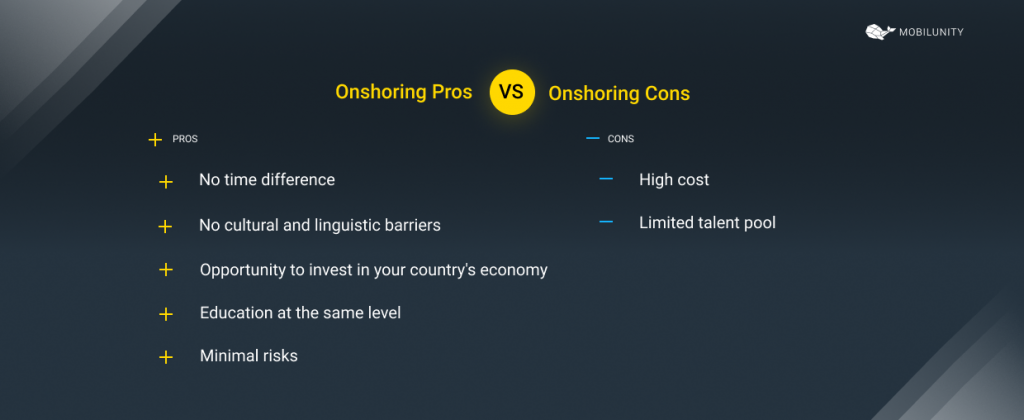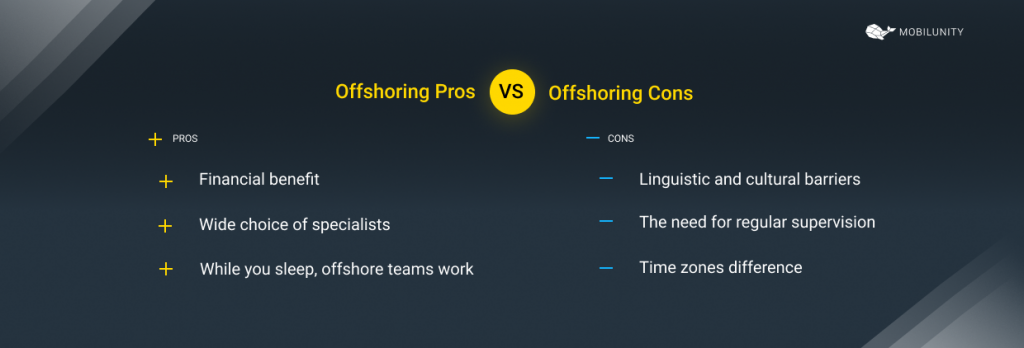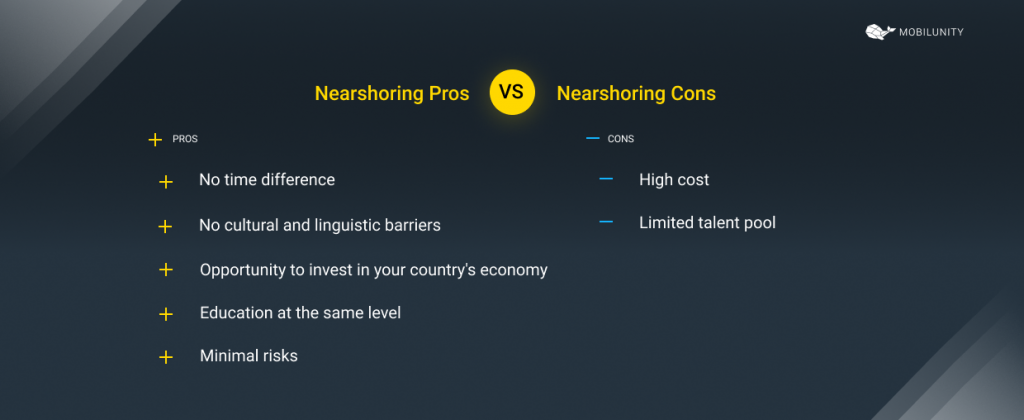Onshoring vs Offshoring in Software Development

Creating new software products necessitates the use of a variety of services, including human resources. It doesn’t matter what you develop: websites, mobile applications, or AI innovations – each of these solutions requires talent. That is why tech companies are increasingly turning to outsourcing as a method of work organization.
But it’s not just the search for talent that pushes companies to outsource. According to Deloitte Global Outsourcing Survey 2020, 70% of businesses choose this employment model for cost reduction. It has become especially relevant given the pandemic. There are various approaches to business process outsourcing, and the most popular among them are the offshore model, onshoring, and nearshoring.
Today we will go through these fundamental types of outsourcing. We also suggest you find out how they differ, including the pros and cons of each approach.
What Is the Difference Between Onshoring, Offshoring, and Nearshoring?
Any technology firm’s goal is to optimize workflows to produce a high-quality final product that is both cost-effective and profitable for the business. Many variables impact the price of software solutions, such as staffing expenses, the complexity of the tasks, and even the platform for software deployment. Therefore, for the most effective organization of development processes, companies choose different approaches to work. In the context of onshoring versus offshoring in software development, nearshoring Estonia stands out as a highly effective strategy, bridging the gap with its advanced tech industry, geographical proximity, and cultural alignment with Western European and Nordic markets.
Offshoring, nearshoring, and onshoring are some of such approaches. These terms are used to describe the transfer of a company’s duties to a third party. As indicated by the annual growth of the outsourcing market in the IT sector, this sort of collaboration between organizations is clearly in demand. This market is expected to reach $413.7 billion by 2021, according to Statista. For comparison, it was $378.1 billion in 2018.
So, let’s consider the terms of onshoring, offshoring, and nearshoring in particular.
What is onshoring? In essence, this is the delegation of business processes to another firm located in the same country as the customer company. Onshoring examples will be outsourcing to another city or transferring responsibilities to an organization that offers more favorable terms. This type of work arrangement is the least risky but usually the most expensive.
Offshoring is the transferring of operational processes to third-party companies located in distant countries. Countries like India, the Philippines, and Eastern Europe (Ukraine, Poland) are among the most favored outsourcing destinations. The peculiarity of this approach is its cost-effectiveness and desire to gain access to a vast talent pool. Substantial differences in time zones and cultural barriers may have a significant influence on work performance when offshoring.
Thus, we move to the last concept, which we will cover in our article. So, what is nearshoring, exactly? It is a type of outsourcing in which a company’s business processes are moved to a firm located in a nearby country. When a business in the United States transfers part of its work to a company in Mexico; or Western European countries outsource to Eastern Europe, these are nearshoring examples. Currently, this sort of collaboration is gaining popularity due to the insignificant time differences and financial benefits.
Pros and Cons of Onshoring
Onshoring may be proper for businesses that require total control over all workflows. This type of outsourcing is beneficial for both well-funded startups, as it minimizes risks, and established companies, as it provides prospects for effective management.
Here are the advantages of this approach that we want to highlight:
- No time difference. Onshoring allows for real-time communication, as well as effortless organizing of meetings with a remote team. It is simple to implement since the collaborating companies are within the same country.
- No cultural and linguistic barriers. When onshoring, work with a third-party company takes place in harmony and complete mutual understanding.
- Opportunity to invest in your country’s economy. With this approach to work, you create jobs for the local workforce. The business culture and quality standards are also transparent within one country.
- Education at the same level. When the work is organized within one country, there should be no unexpected issues related to the candidates’ knowledge level.
- Minimal risks. Onshoring benefits from having the same legal system in one country. It also applies to data protection laws.
Potential disadvantages of onshoring:
- High cost. Onshoring is much more expensive than nearshoring and offshoring. However, of course, you can find companies where the cost of labor will be lower than in your city.
- Limited talent pool. In certain countries, there is simply a scarcity of professionals in a particular sector. As a result, onshoring may not be suitable for every business.
Pros and Cons of Offshoring
When your company aims to grow or can’t handle the workload, there is a need for a new team of specialists. What’s the best way to go about it? There are offshore software development centers that provide their services at affordable prices. But should you be guided by financial gain alone when choosing an offshore approach to work? Let’s get this clear.
We’ll go into the advantages of offshore software development in further detail:
- Financial benefit. Compared to the other two approaches, offshoring is the most cost-effective. You save a lot of money by hiring a team in a country where the average salary is substantially lower.
- Wide choice of specialists. This kind of outsourcing provides advantages like access to a vast talent pool and a wide selection of the best and the brightest. Finding any offshore programmer is not an issue with this form of cooperation.
- While you sleep, offshore teams work. At first glance, the time difference may seem a downside, but you can turn it into a benefit. If you set up all the workflows, define time frames and requirements, you can safely outsource software development to third-party teams.
Here are the potential disadvantages of this approach:
- Linguistic and cultural barriers. These differences can cause various misunderstandings, which will affect performance.
- The need for regular supervision. Given that offshoring involves working with far-flung countries, questions about managing all of these procedures may arise.
- Time zones difference. Even while the time difference might be advantageous, most firms will not benefit from this strategy. Managing a remote team becomes challenging due to the inability to communicate in real-time and make regular calls.
Pros and Cons of Nearshoring
Nearshoring services are a cross between offshoring and onshoring. It is also the ideal outsourcing option widely adopted by various tech companies. Businesses choose nearshore software development because this approach combines the best features of offshoring and onshoring.
Here are the main nearshoring benefits:
- No or insignificant time difference. It is an advantage of near-shoring, as it enables real-time communication. Furthermore, the schedules of the cooperating companies’ teams will coincide, making it simple to get in touch.
- Geographical closeness. It allows for live meetings to be arranged at a relatively low cost.
- Linguistic and cultural closeness. Neighboring countries have an idea of each other’s cultures, so there will be no miscommunications on this basis. And some nearby areas even speak the same language.
- Relative financial benefit. A nearshoring company can offer you more favorable conditions for cooperation than a firm in your country. It is the essence of this approach to work.
What are the disadvantages of this type of outsourcing?
- Limited choice of specialists. It is the biggest problem that a company planning to work on a nearshoring model may face. The selection of talents is limited to neighboring countries – so the search can be challenging.
Offshoring vs Onshoring vs Nearshoring
Business process outsourcing has many types, three of which we have described today. There are several distinctions between these approaches to work organization, but the location of a third-party company may be the most relevant.
We’ll illustrate the other differences between on-, off- and nearshoring in the table below.
Mobilunity as Your Outsourcing Option
We are a Ukrainian IT company that offers outsourcing, offshoring, and nearshoring services to clients worldwide. We’ve been assisting businesses in more than 15 countries over the last eleven years. During this time, we have managed to work with more than 40 companies in France, Germany, Switzerland, Israel, and the Netherlands.
We specialize in digitalization, fintech, SAAS product development, implementation of trading solutions, e-commerce, data management, and even more. Some of the projects we are proud of include esurance (Switzerland), FinExpert (Canada), and Zenchef (France).
Mobilunity enables the company to scale, effectively manage employees, control resources and finances, and improve overall performance. We also offer favorable rates and qualified professionals. Let’s create a team of your dreams together, establish software development partnership and make your ideas a reality.
Looking for a nearshore software development team? Choose a reliable nearshore provider – Mobilunity!
Disclaimer: All salaries and prices mentioned within the article are approximate NET numbers based on the research done by our in-house Recruitment Team. Please use these numbers as a guide for comparison purposes only and feel free to use the contact form to inquire on the specific cost of the talent according to your vacancy requirements and chosen model of engagement.










